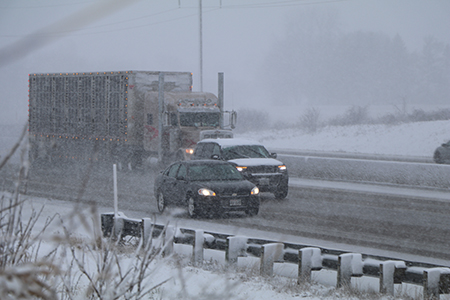
Traveling on wintry roadways can be challenging and stressful. Following some simple guidelines will help ensure that you reach your destination safely.
During severe winter storms, consider postponing your trip until travel conditions improve. Stranded vehicles and motorists create additional hazards for plow operators, law enforcement and other emergency responders. When travel is necessary:
- Before heading out, learn the latest about highway conditions and incidents by visiting
511wi.gov. Let others know about your planned route and expected arrival time. Fully charge your cell phone.
- Clear snow and ice from your vehicle’s windows, front and rear lights, roof and hood. Ensure everyone is buckled up.
- Take it slow. Allow extra travel time and following distance. Most winter crashes and slide-offs are caused by drivers going too fast for the existing conditions. Remember, posted speed limits apply to ideal travel conditions.
- Turn on your vehicle’s low-beam headlights. This helps you see what’s ahead, and helps other drivers see you. State law requires drivers to turn on their vehicle’s low-beam headlights any time that weather or other conditions make it difficult to see objects 500 feet ahead.
- Sudden braking or steering can cause you to lose control of your vehicle. Use brakes early and carefully. With anti-lock-brakes (ABS), use firm, steady pressure and gently steer. Never use cruise control in wintry weather.
- Don’t be overconfident in your four-wheel or all-wheel-drive vehicle. All vehicles require additional time and distance to stop in adverse conditions.
- Remember that bridge decks/overpasses can be especially slippery, even when adjacent pavements are in good travel condition.
- Watch for snowplows. Stay at least 200 feet behind a working plow and use extra caution if you decide to pass. Plows often create a cloud of snow that can obscure visibility, and road conditions ahead of the plow are likely worse.
- Keep a safe distance behind large trucks. Along with obscuring your view of the road ahead, pieces of snow or ice can blow off the top of commercial trucks as they travel down the highway.
- Winter storm advisories/warnings are routinely posted on Dynamic Message Signs along major highway corridors. Heed this information and drive accordingly. Winter storm events often have moderate to significant travel impacts.
- Be mindful of your location using crossroads, mileposts or key landmarks. If you do become stranded, you’ll be better prepared to describe your location for law enforcement or tow truck operators.
Downloadable poster on basic winter driving tips.
One Minute WisDOT video on safety around snowplows
Other resources
Statutory reference: Ch. 343